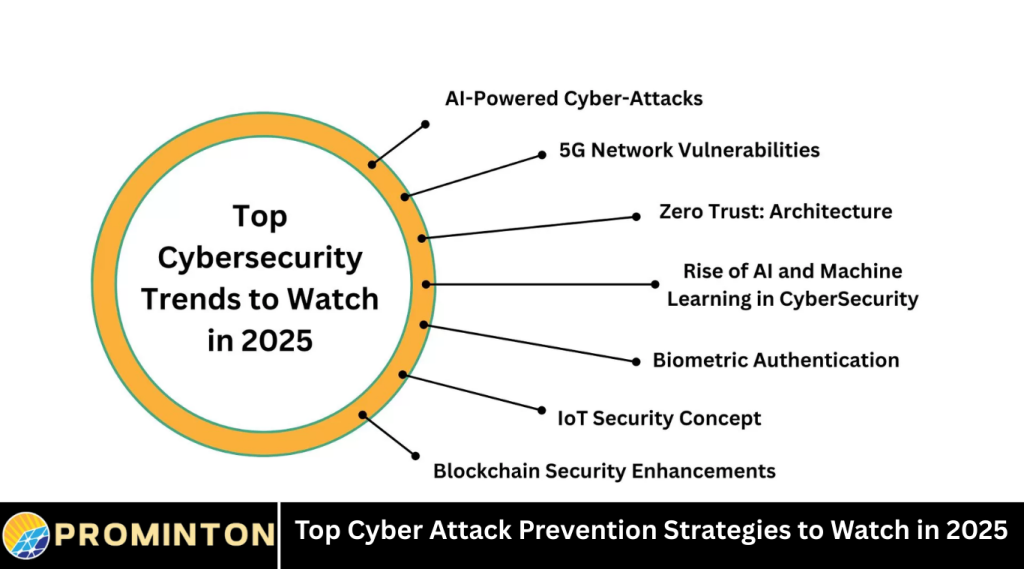In today’s digital age, cyber attacks are growing in both frequency and complexity. Businesses, governments, and individuals face an increasing number of threats that can lead to data breaches, financial loss, and reputational damage. As technology advances, cybercriminals develop new methods to exploit vulnerabilities.
Looking ahead to 2025, it is critical for organizations to stay ahead by adopting the latest cyber attack prevention strategies. These strategies focus on strengthening defenses, detecting threats early, and responding effectively to minimize damage.
This article explores the most effective cyber attack prevention strategies that organizations should prioritize in 2025. Understanding and implementing these approaches can help build resilience and protect valuable assets from evolving cyber threats.
Understanding the Cyber Threat Landscape in 2025
Cyber attacks are becoming more sophisticated with the rise of new technologies such as artificial intelligence, the Internet of Things (IoT), and cloud computing. Attackers use these technologies to launch more targeted, automated, and damaging attacks.
Common types of cyber attacks include phishing, ransomware, malware, Distributed Denial of Service (DDoS), and insider threats. Emerging threats involve AI-powered attacks and exploiting vulnerabilities in smart devices.
The increasing interconnectedness of devices and reliance on digital infrastructure mean that even small security gaps can have widespread consequences. Therefore, it is important to adopt comprehensive prevention strategies that cover technology, people, and processes.
Building a Strong Security Foundation
A solid foundation is key to preventing cyber attacks. This involves securing networks, systems, and data through best practices.
Implementing Multi-Factor Authentication
Passwords alone are often not enough to protect accounts. Multi-factor authentication (MFA) adds an extra layer of security by requiring users to provide multiple forms of verification, such as a password and a code sent to their phone.
MFA reduces the risk of unauthorized access even if passwords are compromised. In 2025, organizations should make MFA mandatory for all critical systems and sensitive data access.
Regular Software Updates and Patch Management
Cyber attackers frequently exploit known vulnerabilities in software. Applying regular updates and patches fixes these weaknesses and prevents attackers from gaining entry.
Automating patch management helps ensure updates are applied promptly and consistently. Organizations need to monitor their software inventory and stay informed about security advisories.
Network Segmentation
Dividing the network into separate segments limits the spread of an attack. If a hacker gains access to one part of the network, segmentation prevents them from moving freely to other areas.
This approach minimizes potential damage and improves monitoring by isolating critical systems from less secure zones.
Leveraging Artificial Intelligence and Machine Learning
Artificial intelligence (AI) and machine learning (ML) are transforming cybersecurity by enabling proactive threat detection and response.
AI-Powered Threat Detection
AI systems analyze vast amounts of data to identify unusual patterns that may indicate an attack. These systems can detect threats in real time and alert security teams before significant damage occurs.
Machine learning models improve over time by learning from new threats and adapting to evolving attack methods. Using AI for threat detection is becoming essential in 2025 to keep pace with increasingly sophisticated cyber attacks.
Automated Incident Response
When a threat is detected, speed is critical to contain and mitigate the impact. AI can automate incident response by isolating affected systems, blocking malicious traffic, and initiating recovery processes without human delay.
Automation reduces response times and allows cybersecurity teams to focus on strategic tasks rather than routine firefighting.
Strengthening Endpoint Security
Endpoints such as laptops, smartphones, and IoT devices are common entry points for attackers. Securing these devices is vital.
Endpoint Detection and Response Solutions
Endpoint Detection and Response (EDR) tools monitor devices continuously for suspicious behavior. They provide visibility into endpoint activity, enabling quick detection and investigation of threats.
In 2025, deploying advanced EDR solutions helps organizations identify zero-day attacks and insider threats that traditional antivirus software might miss.
Securing IoT Devices
The growing number of IoT devices introduces new vulnerabilities. Many IoT devices have limited security features and can be exploited as entry points.
Organizations should implement strict security policies for IoT devices, including network segmentation, regular updates, and device authentication.
Enhancing Employee Awareness and Training
Human error remains one of the leading causes of cyber breaches. Phishing attacks and social engineering exploit users’ lack of awareness.
Cybersecurity Training Programs
Regular training educates employees about common cyber threats and safe practices. It builds a security-conscious culture where employees recognize and report suspicious activity.
Training should include simulated phishing campaigns to test readiness and reinforce lessons.
Clear Security Policies
Organizations must communicate clear security policies regarding password use, data handling, and device usage. Employees should understand their roles in maintaining security.
A culture of accountability encourages everyone to contribute to cyber defense.
Implementing Zero Trust Security Model
The traditional perimeter-based security model is no longer sufficient due to remote work and cloud adoption. The Zero Trust model assumes that no user or device is inherently trustworthy.
Continuous Verification
Zero Trust requires continuous verification of user identity and device health before granting access to resources. This minimizes the risk of insider threats and compromised credentials.
Least Privilege Access
Users are granted the minimum access necessary to perform their tasks. This limits the potential damage if an account is compromised.
By adopting Zero Trust, organizations can reduce attack surfaces and improve overall security posture.
Securing Cloud Environments
Cloud computing offers flexibility but also introduces security challenges.
Cloud Security Best Practices
Organizations should configure cloud environments securely, applying encryption, access controls, and monitoring.
Regular audits help identify misconfigurations that could lead to data leaks or unauthorized access.
Cloud Access Security Brokers
Cloud Access Security Brokers (CASBs) provide visibility and control over cloud services, enforcing security policies and detecting threats.
In 2025, using CASBs will be a key strategy for managing cloud security risks.
Preparing for Ransomware Attacks
Ransomware continues to be a major threat, locking organizations out of their data until a ransom is paid.
Regular Backups and Recovery Plans
Maintaining frequent, secure backups ensures that data can be restored without paying ransom. Testing recovery plans regularly ensures preparedness.
Network Monitoring and Segmentation
Early detection of ransomware activity and network segmentation can limit its spread.
Employee Training
Educating employees about phishing and suspicious links reduces the risk of ransomware infections.
Continuous Monitoring and Threat Intelligence
Maintaining awareness of emerging threats is essential.
Security Operations Centers
Many organizations operate Security Operations Centers (SOCs) that continuously monitor networks and respond to incidents.
Threat Intelligence Sharing
Sharing threat intelligence with industry peers and government agencies helps identify new attack vectors and coordinate defenses.
Frequently Asked Questions
What is the most effective way to prevent cyber attacks?
A combination of strategies including multi-factor authentication, regular updates, employee training, and continuous monitoring provides the best protection.
How does AI help in cybersecurity?
AI analyzes data patterns to detect threats in real time and can automate responses to contain attacks quickly.
Why is employee training important for cyber attack prevention?
Employees are often targeted by phishing and social engineering attacks. Training increases awareness and reduces human error.
What is the Zero Trust security model?
Zero Trust means no user or device is automatically trusted; continuous verification and least privilege access are enforced to reduce risk.
How can organizations protect IoT devices?
Securing IoT involves strong authentication, network segmentation, regular updates, and monitoring device activity.
What should organizations do to prepare for ransomware?
Maintain secure backups, train employees on phishing risks, monitor networks, and have tested recovery plans.
Why is continuous threat monitoring necessary?
Cyber threats evolve constantly. Continuous monitoring helps detect and respond to new threats before they cause damage.
Conclusion
The cyber threat landscape in 2025 will continue to evolve with new technologies and attack methods. To stay protected, organizations must adopt a multi-layered approach combining technology, processes, and people.
Building a strong security foundation with practices like multi-factor authentication and patch management is critical. Leveraging AI and machine learning enhances threat detection and response. Endpoint and cloud security, employee training, and adopting Zero Trust models further strengthen defenses.



